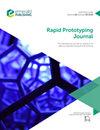定向能沉积中加工参数对温度历史的影响建模:一种分析和有限元方法
IF 3.6
4区 工程技术
Q1 ENGINEERING, MECHANICAL
引用次数: 0
摘要
目的本文旨在评估分析模型(特别是径向基函数法、Akbari-Ganji 法和高斯法)与有限元法相结合的可行性。设计/方法/途径通过分析调查和有限元模拟,本研究探讨了加工参数对温度历史的影响。有限元模拟使用了 Simufact 软件的热力学方法,而分析建模则使用了径向基函数、Akbari-Ganji 和高斯方法来求解传热微分方程。研究结果表明,热导率(从 100 到 200)、激光功率(从 400 到 800 W)、热源深度(从 0.35 到 0.75)和功率吸收系数(从 0.4 到 0.8)之间存在直接关系。这些参数值的增加会导致更高的温度历史。另一方面,密度(从 7,600 升至 8,200)、发射系数(从 0.5 升至 0.7)和对流传热(从 35 升至 90)与历史温度呈反比关系。原创性/价值分析建模的应用,特别是 Akbari-Ganji 方法、径向基函数和高斯方法的使用,展示了研究定向能量沉积的创新方法。这种分析研究提供了完全依赖实验程序的替代方法,有可能为定向能沉积过程的优化节省时间和资源。本文章由计算机程序翻译,如有差异,请以英文原文为准。
Modeling the effect of processing parameters on temperature history in Directed Energy Deposition: an analytical and finite element approach
Purpose
The purpose of this paper is to assess the feasibility of analytical models, specifically the radial basis function method, Akbari–Ganji method and Gaussian method, in conjunction with the finite element method. The aim is to examine the impact of processing parameters on temperature history.
Design/methodology/approach
Through analytical investigation and finite element simulation, this research examines the influence of processing parameters on temperature history. Simufact software with a thermomechanical approach was used for finite element simulation, while radial basis function, Akbari–Ganji and Gaussian methods were used for analytical modeling to solve the heat transfer differential equation.
Findings
The accuracy of both finite element and analytical methods was validated with about 90%. The findings revealed direct relationships between thermal conductivity (from 100 to 200), laser power (from 400 to 800 W), heat source depth (from 0.35 to 0.75) and power absorption coefficient (from 0.4 to 0.8). Increasing the values of these parameters led to higher temperature history. On the other hand, density (from 7,600 to 8,200), emission coefficient (from 0.5 to 0.7) and convective heat transfer (from 35 to 90) exhibited an inverse relationship with temperature history.
Originality/value
The application of analytical modeling, particularly the utilization of the Akbari–Ganji, radial basis functions and Gaussian methods, showcases an innovative approach to studying directed energy deposition. This analytical investigation offers an alternative to relying solely on experimental procedures, potentially saving time and resources in the optimization of DED processes.
求助全文
通过发布文献求助,成功后即可免费获取论文全文。
去求助
来源期刊

Rapid Prototyping Journal
工程技术-材料科学:综合
CiteScore
8.30
自引率
10.30%
发文量
137
审稿时长
4.6 months
期刊介绍:
Rapid Prototyping Journal concentrates on development in a manufacturing environment but covers applications in other areas, such as medicine and construction. All papers published in this field are scattered over a wide range of international publications, none of which actually specializes in this particular discipline, this journal is a vital resource for anyone involved in additive manufacturing. It draws together important refereed papers on all aspects of AM from distinguished sources all over the world, to give a truly international perspective on this dynamic and exciting area.
-Benchmarking – certification and qualification in AM-
Mass customisation in AM-
Design for AM-
Materials aspects-
Reviews of processes/applications-
CAD and other software aspects-
Enhancement of existing processes-
Integration with design process-
Management implications-
New AM processes-
Novel applications of AM parts-
AM for tooling-
Medical applications-
Reverse engineering in relation to AM-
Additive & Subtractive hybrid manufacturing-
Industrialisation
 求助内容:
求助内容: 应助结果提醒方式:
应助结果提醒方式:


